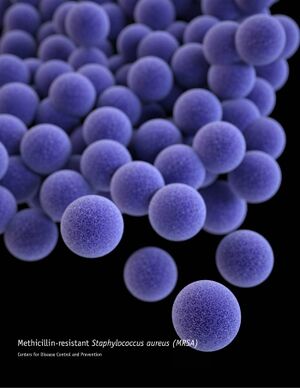Staphylococcus aureus: Evasion of neutrophils: Difference between revisions
No edit summary |
No edit summary |
||
| Line 31: | Line 31: | ||
<br><br> | <br><br> | ||
== | ==Avoid phagocytosis by aggregation, surface structure, and biofilm== | ||
Include some current research, with a second image.<br><br> | Include some current research, with a second image.<br><br> | ||
Revision as of 14:35, 7 December 2022
Introduction
Staphylococcus aureus (S. aureus), also known as “golden staph” and “oro staphira”, is a member of Bacillota.
S. aureus is a common type of bacteria that appears everywhere in our daily life and has a high lethal rate all around the world.
S. aureus is commonly found in the environment such as soil, water, and air, and also in the nose and on the skin of humans and animals.
Its high lethality is due to its high antibiotic resistance. In the past, doctors used penicillin to treat patients with S. aureus infection but the antibiotic no longer kills the bacteria by the end of 1940s.
S. aureus is famous for its serious infection reaction in the human body. In order for bacteria to cause infection in the human body, they need to escape from the immune system. S. aureus has developed a number of strategies to survive outside of the immune system before infecting a cell. Besides, S. aureus seems to be inextirpable in that it is resistant to nearly all types of antibiotics. Whenever a new drug is tested against S. aureus infection, it fails after preliminary successes.
The infection of S. aureus is completed within the human body. After S. aureus enters the bloodstream, it will be detected by the immune system. Neutrophils, mast cells and different kinds of immune cells quickly respond to the infection site, causing inflammation reaction and other signaling pathways that command the body to fight against the intruder. While they are still in the bloodstreams, S. aureus have a wide variety of mechanisms to avoid being killed by neutrophils. For example, they release cytotoxic compounds to kill phagocytes which inhibit the function of neutrophils.

When S. aureus enter the body from (), they travel along the bloodstream to [some organs][cite]. The immune cells in the bloodstreams are a major threat to S. aureus as theyhave to avoid being attacked by the immune system. The strategies used by S.aureus include neutrophils activation and chemotaxis inhibition, phagocytosis inhibition, opsonization suppression, and neutrophils elimination. In specific, S.aureus inhibits phagocytosis by aggregation, protective surface proteins, and biofilm structures and kills neutrophils by cytolytic toxins or apoptosis.
Inhibition of neutrophil extravasation, activation, and chemotaxis
Include some current research, with at least one image.
Sample citations: [1]
[2]
A citation code consists of a hyperlinked reference within "ref" begin and end codes.
For multiple use of the same inline citation or footnote, you can use the named references feature, choosing a name to identify the inline citation, and typing [4]
Second citation of Ref 1: [1]

Avoid phagocytosis by aggregation, surface structure, and biofilm
Include some current research, with a second image.
Inhibition of opsonization
still being edited
Inhibition of neutrophil killing mechanisms
still editing.
Toxin-driven elimination of neutrophils
editing.
Conclusion
Overall text length (all text sections) should be at least 1,000 words (before counting references), with at least 2 images.
Include at least 5 references under References section.
References
- ↑ 1.0 1.1 Hodgkin, J. and Partridge, F.A. "Caenorhabditis elegans meets microsporidia: the nematode killers from Paris." 2008. PLoS Biology 6:2634-2637.
- ↑ Bartlett et al.: Oncolytic viruses as therapeutic cancer vaccines. Molecular Cancer 2013 12:103.
- ↑ Lee G, Low RI, Amsterdam EA, Demaria AN, Huber PW, Mason DT. Hemodynamic effects of morphine and nalbuphine in acute myocardial infarction. Clinical Pharmacology & Therapeutics. 1981 May;29(5):576-81.
- ↑ 4.0 4.1 text of the citation
Edited by Reina He, student of Joan Slonczewski for BIOL 116 Information in Living Systems, 2022, Kenyon College.
